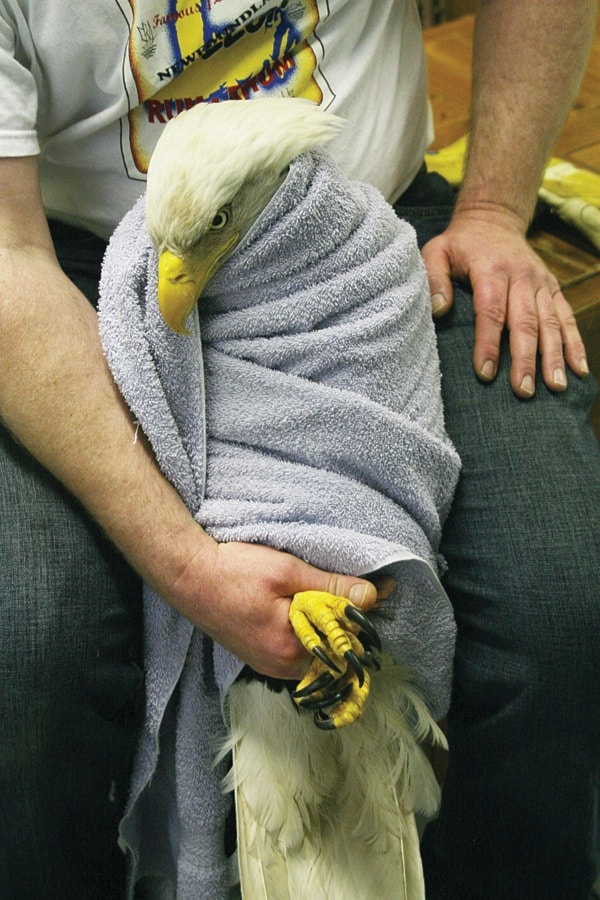With surprising agility and gentleness for a big guy, Reg Westcott demonstrates how one person feeds an injured bald eagle.
“As a rehabber, you have to be a bit of an octopus,” he says.
First the emaciated raptor is wrapped in a thick bath towel so it doesn’t start flapping its large wings in the rather small recovery room.
Next he steadies the eagle between his legs. Then with one bare hand, he holds open its sharp beak and inserts the feeding tube far down its throat with the other.
He’s almost ready now as he tilts the eagle’s head up, clutches the large feeding syringe with his free hand and then uses his chin to compress the plunger, sending a yellow stream of liquified chicken lunch into the eagle’s belly.
“It takes a bit of practice,” he tells a female volunteer who, for her first time, was trying to assist Westcott with one of the five-times-a-day feedings.
The volunteer at the Mountainaire Avian Rescue Society (MARS) is perturbed for failing at what seems to be such a simple task. But there is nothing simple about saving injured birds and other wildlife.
From the secret food formulas fed to the injured and growing birds, to the hundreds of other little tricks it takes to get them to eat, heal and recover, saving wildlife takes years of knowledge and patience.
It’s something Westcott learned himself when he was recovering from a serious work accident seven years ago.
“I was in a terrible marine accident and during my recovery I started volunteering here. Now I’d like to think I’m indispensable,” he says with a laugh.
Westcott graduated from a volunteer to a full-time animal technician and educational outreach worker.
One of his favourite tricks is to use eagle puppets and toys to get injured, and stubborn, raptors to feed.
“Eagles are greedy eaters, so sometimes I tease them with the puppet. That gets them eating,” he says.
But Westcott is just one man in a staff of few. It takes thousands of volunteer hours and thousand of dollars in donations to keep the recovery centre in Merville running.
“With eagles, you often need two handlers,” notes Pearl McKenzie, the society’s vice-president. “With baby birds, they can require 42 feedings a day. It’s really intense.”
During baby bird season, volunteers walk around with egg timers to remind themselves when the next feeding is due. They’ve even saved baby hummingbirds that come in the “size of a small peanut.”
But it’s hard to save a baby bird. Half don’t survive. Larger birds and raptors stand a better chance of recovering and survival, but there’s no guarantee.
In her Feb. 15 column for the Mirror, Sandy Fairfield wrote about two barn owls found in a chimney and taken to MARS to recover. The male survived, but the female died last week.
“A lot don’t make it. They’re usually really stressed out by the time we find them,” says McKenzie.
More eagles
While small birds require a lot of short-term care to become healthy, they’re relatively inexpensive to care for in contrast to owls and raptors.
An owl eats five to seven mice per day – all bought because wild mice may be contaminated or can pass along disease. Bald eagles eat salmon and fortunately most fish MARS receives is donated, along with approximately $50,000 annually from supporters in Campbell River and the Comox Valley.
The large birds also require more time to recover and must be taken to other recovery centres in Errington or on the Lower Mainland in order to get in flying time before they’re released back into the wild.
A full-sized flight pen is something that MARS lacks. A recovering raptor requires an enclosure roughly 120 feet long, by 40 feet wide, by 30 feet high.
To build one would exceed an entire year’s budget at MARS, but it’s needed, explains Westcott. Each time a bird is transferred to another centre, that puts more stress on the animal. As well, MARS is seeing increasing numbers of injured bald eagles.
The average was about 30 eagles a year. Last year, 51 eagles were treated at MARS and so far this year, the tally is 11.
“I wouldn’t be surprised if we saw 60 this year,” says Westcott. “It’s hard to say why there’s more…the Comox Valley is a bread basket for eagles. They arrive from all over. Who knows, maybe the food supply in other spots isn’t so good? And that can lead to other potential problems such as more competition amongst the birds.”
One bald eagle currently recovering at MARS is known as “Semi” because she was feeding on road kill when she flew up and straight through the window of a semi-truck.
“Semi suffered a fractured pelvis, but she’s flying really well,” says Westcott.
In addition to small birds and raptors, MARS has rehabilitated other indigenous wildlife. McKenzie says MARS is successful due to the generosity of individual and corporate supporters, like BC Hydro, and the many volunteers.
“There’s a lot of people who quietly keep the centre going and doing a lot of the dirty jobs like cleaning up poop, cages and washing tools,” she says.
Visit www.wingtips.org or call 250-337-2021.
